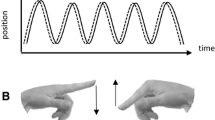Abstract
The problems that autistic individuals show in the areas of interpersonal relationships and language have been long recognized and are well documented. Nonverbal behaviors and their implications for overall affective and cognitive development have received far less scrutiny. The purposes of this paper are to investigate the significance of movement behaviors in the differential diagnosis of autism, to present a newly developed assessment tool and observational procedure for gathering data in nonverbal areas of concern and to illustrate appropriate statistical measures which can be used to determine whether there are specific nonverbal behaviors which distinguish autistic individuals from other groups of severely disabled persons. The results show that studies of nonverbal behaviors are important in that autistic persons show a variety of anomalies, but that one must be very selective in using nonverbal behaviors for differential diagnoses since individuals with other developmental disorders also exhibit deviations in a variety of movement areas. The number of problems and the degree to which they are exhibited suggest that dance/movement therapy is an appropriate intervention for several developmentally disabled populations.
Similar content being viewed by others
References
American Psychiatric Association (1980).Diagnostic and statistical manual (DSM III). Washington.
Brown, W. T., Friedman, E., Jenkins, E. C., Brooks, J., Wisniewski, K., Raguthu, S. & French, J. H. (1982). Association of fragile (X) syndrome with Autism.The Lancet, January 9,1, 100.
Brown, W. T. & Jenkins, E. C. (1984). Fragile X syndrome. In: Berg, J. M. (Ed.)Perspectives and progress in mental retardation, Volume II—Biomedical aspects, Baltimore: University Park Press.
Churchill, D. W. (1972). The relation of infantile autism and early childhood schizophrenia to developmental language disorders of childhood.Journal of Autism and Childhood Schizophrenia.2, 182–197.
Cohen, I. L., Fisch, G. S. & Wolf, E. G. (1985). Fragile X and autism: A preliminary analysis of behavioral characteristics. Paper accepted for presentation. 93rd Annual meeting of the American Psychological Association. Los Angeles, CA.
DeMyer, M. K., Hingtgen, J. N. & Jackson, Roger K. (1981). Infantile Autism reviewed: A decade of research.Schizophrenia Bulletin, 7, 389–451.
Dixon, W. J. (Ed.) (1983).BMDP Statistical Software. California: UCLA Press.
Fisch, G. S., Cohen, I. L., Wolf, E. G., Friedman, E. (1985). The autistic discriptors checklist (ADC): A preliminary report.Journal of Autism & Developmental Disorders, 15(2), 233–234.
Fried, J. P. (1980). Validation and application of the Behavior Rating Instrument for Autistic and Other Atypical Children for use with low functioning blind and visually impaired children. Masters Thesis, Immaculate Heart College.
Friedman, E., Wolf, E., Cohen, I. & Fisch, G. (1985). “Autistic Descriptors Checklist”: NYS Institute for Basic Research in Developmental Disabilities.
Herbst, D. S., Dunn, H. G., Dill, F. J., Kalousek, D. K. & Krywaniuk, L. W. (1981). Further delineation of X-linked mental retardation.Human Genetics, 7.
Jacobs, P. S., Glover, T. W., Mayer, M., Fox, P., Gerrard, J. W., Dunn, H. G., & Herbst, D. S. (1980). X-linked mental retardation: A study of seven families.American Journal of Medical Genetics, 7, 471–489.
Kanner, L. (1943). Autistic Disturbances in Affective Contact,Nervous Child, 2, 217–250.
Kazdin, A. E. (1977). Artifact, bias and complexity of assessment: The ABC's of reliability.Journal of Applied Behavior Analysis, 10, 141–150.
Levitas, A., McBogg, P. & Hagerman, R. (1983). Behavioral dysfunction in the fragile X syndrome. In: Hagerman, R. & McBogg, P. (Eds.)The Fragile X syndrome: Diagnosis, biochemistry and intervention. Dillon, CO: Spectra Publishing Co., 153–173.
Liebetrau, A. M. (1983).Measures of Association. Beverly Hills, CA: Sage.
Lubs, H. A. (1969). A marker X chromosome.American Journal of Human Genetics, 21, 231–244.
Ornitz, E. M. (1973). Childhood autism—A review of the clinical and experimental literature.California Medicine, 118, 21–27.
Ritvo, E. & Freeman, B. J. (1978). National Society for Autistic Children definition of the syndrome of autism.Journal of Autism & Childhood Schizophrenia, 8, 162–169.
Rutter, M., Bartak, L. & Newman, S. (1971). Autism — A central disorder of cognition and language? In: Rutter, M., (Ed.)Infantile autism: concepts, characteristics, and treatment. London: Churchill — Livingstone, 148–171.
Ruttenberg, B. A. & Wolf, E. G. (1967). Evaluating the communication of the autistic child.Journal of Speech and Hearing Disorders, 32, 314–324.
Ruttenberg, B. A., Kalish, B. I., Wenar, C. & Wolf, E. G. (1977).Behavior Rating Instrument for Autistic and Other Atypical Children. Chicago: Stoelting Co.
Sparrow, S., Balla, D. & Cicchetti (1984).Vineland Adaptive Behavior Scales. Circle Pines, MN, American Guidance Service.
Wechsler, D. (1974).Manual for the Wechsler Intelligence Scale for Children Revised. New York: Psychological Corp.
Wolf, E., Wenar, C. & Ruttenberg, B. A. (1972). A comparison of personality variables in autistic and mentally retarded children.Journal of Autism and Childhood Schizophrenia, 2, 92–108.
Wolf, E. (1984). Report to National Institute of Mental Health, Project 1R03 MH 37513 01A1. Development of a valid assessment scale for autism.
Author information
Authors and Affiliations
Additional information
This work was supported in part by the National Institute of Mental Health grants MH 37513-01A1 and MH 38201-01.
Rights and permissions
About this article
Cite this article
Wolf-Schein, E.G., Fisch, G.S. & Cohen, I.L. A study of the use of nonverbal systems in the differential diagnosis of autistic, mentally retarded and fragile X individuals. Am J Dance Ther 8, 67–80 (1985). https://doi.org/10.1007/BF02251442
Issue Date:
DOI: https://doi.org/10.1007/BF02251442




